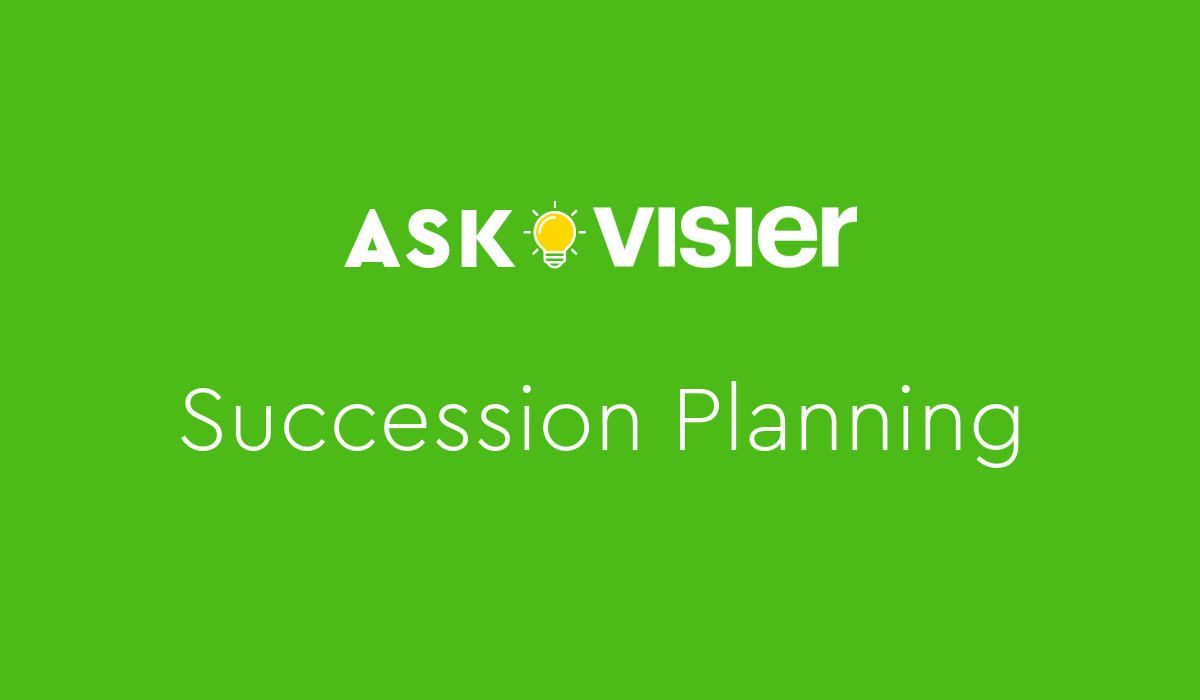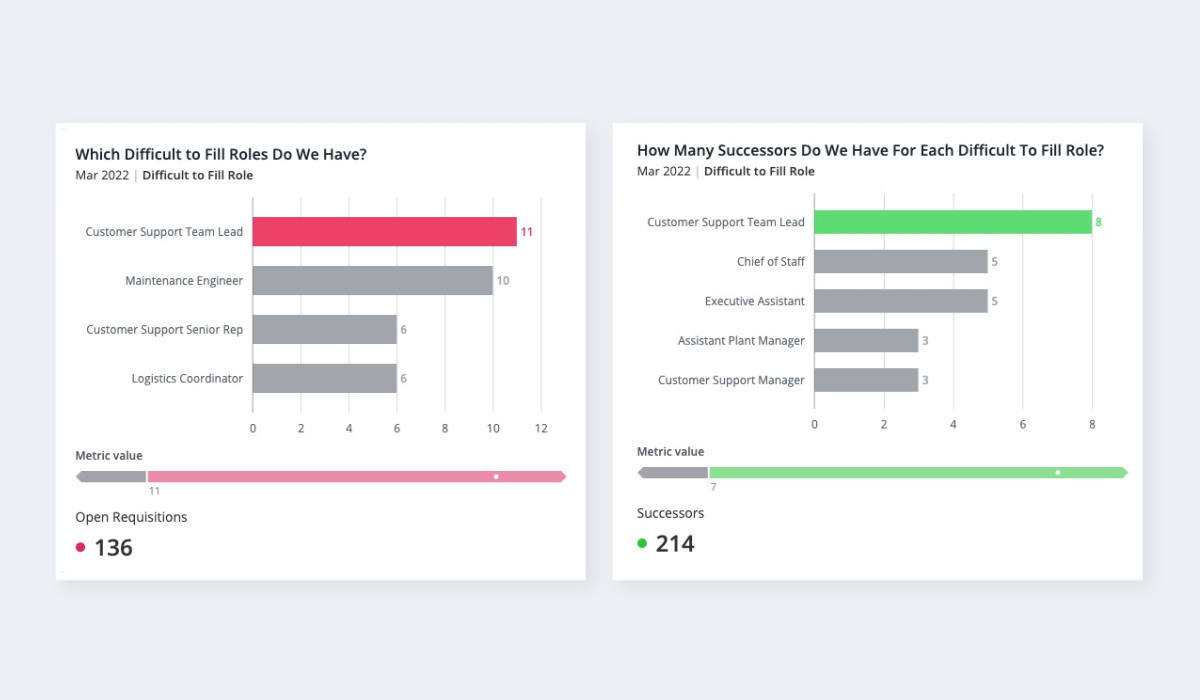Ask Visier: What Leadership and Succession Risks Need to be Reviewed and Managed?
Succession planning means having candidates ready to be promoted into crucial roles. Find out how Visier can provide valuable insights.

Ask Visier is a weekly column where a people analytics expert dives into one of the 2000+ business questions available in Visier and shares how to take action on the answers you might uncover on that topic.
Succession planning means knowing which key roles are going to be vacated eventually and having a candidate pool of employees ready to step up into those roles. In the wake of the Great Resignation, demand for talent is at an all-time high, with many employees receiving increased attention from recruiters looking to pull them away from their current employers. These employees understand that it’s a “buyer’s market” and expect their current employer to offer more in exchange for their expertise and services. Employers are also feeling the pressure of the Baby Boomer generation, whose retirement rates have been accelerating.
All this market activity means that organizations must face the very real possibility that key talent who occupy crucial positions within the organization may retire or resign at any time, leaving the organization exposed to operational or service failure, or even the loss of key clients. By understanding these leadership and succession risks and creating a talent contingency plan, organizations can better plan for and limit workforce disruption.
But it’s not just about reducing the negative impact of employees who suddenly exit. Succession planning is often considered an essential tool for sustainable workforce strategic planning, and both HR and people managers can use it as an opportunity for effective retention and stay conversations.
How does succession planning affect retention?
Monetary compensation effectively serves as the “cost” to an employer to retain an employee, so succession planning can add a much needed option to the toolkit of retention strategies, especially for organizations that may not have the budget for a salary increase. Identifying a succession path ensures that talented individuals are retained, along with their institutional knowledge and network.

Knowing which roles you have to fill and how many successors can alert you to future issues.
How does succession planning prove resiliency?
The market wants to know if your organization is resilient to change, and there’s a regulatory push to start turning to human capital reporting standards such as ISO-30414. Succession plan coverage is needed to communicate a company’s workforce resiliency, and how their talent needs are aligned with future growth plans and business goals. Asking questions about leadership and succession risks, while aligning on specific ISO metrics, will allow an HR pro to communicate the resilience of their workforce out to the market and future customers.
Dive deeper with these other questions:
Do the drivers of managerial resignation differ between managers in various business units?
Do the skills of the successor match the person they are to replace?
Are there difficult-to-fill open positions that could be better filled with internal talent?
What can the data tell you about how to manage and review these risks?
Forewarned is forearmed. Leveraging accurate and relevant data can help minimize the impact of leadership turnover. Once the risk is better understood, leaders can begin creating succession plans and engaging employees to better prepare for any change.
People leaders and HR must understand who will potentially succeed an incumbent to get role-relevant and strategically significant professional development plans ready for the successor. By understanding the various stages of readiness that an employee can have in preparation for their new role, leaders can figure out who might be ready to move up. But it’s more than just identifying good candidates; you also have to give emerging leaders the right kinds of experiences and development opportunities well before you need them to be ready to fill a suddenly vacant leadership role.
Other data that can help:
Analyzing which business units have higher rates of voluntary resignation of managers and other leaders. These business units should be prioritized for succession planning.
How many succession plans is an employee a part of, and how many plans will ‘break’ if this employee leaves or gets promoted into a new position?
How often do employees get promoted according to plan?
Which organizations have very low rates of promotion but high manager turnover?
When will critical leadership talent reach retirement eligibility and which parts of the organization will be affected the most?
What is the bench strength for a given incumbent position? Have we identified any emergency successors and are those employees still with the organization?
Understanding the various leadership and succession risks—and implementing a good response plan—requires both data and the tools to visualize and work with the data to support decisions.
How does succession planning affect DEI?
Succession planning affects the diversity, equity, and inclusion (DEI) initiatives that permeate many of HR’s functions. Often, succession plans created in a vacuum result in promoting only the people who demographically resemble those they’re replacing. This results in a homogenous pipeline of successors, which may not meet the DEI targets of the organization. Non-diverse successor pipelines can damage a company’s performance and culture, while communicating the lack of mobility options for diverse employee groups.
Some HRIS systems have succession planning capabilities, however, important pipeline diversity trends and successor pool coverage insights can be hidden in the transactional reports these systems generate. Some HRIS systems may also let leaders make ad-hoc updates to a succession plan to impact pipeline readiness or org-wide DEI goals. But if a people leader doesn’t know how these decisions affect key metrics like successor pool coverage or diversity target ratios, these decisions could have adverse effects in the form of underdeveloped pipelines or succession picks that reinforce bias.

Seeing long term demographic trends for successors can let you know if your DEI efforts are on track.
Why is it a challenge to get a good picture of succession planning risks without Visier?
Information about which leaders are at risk of exiting, or who are minimizing development opportunities for direct reports can appear in a variety of data sources, for example from poor upward feedback survey results that can only be found in your survey system. Making informed decisions about successors should be supported by getting a sense of the skills incumbents may have and ensuring their successors have those same skills. This is difficult because that data is kept in another skill management system and is often changing as employees develop their skills over time.
To make confident decisions about leadership turnover trends, you need accurate, up-to-date data to show when managers leave the company and why. Your analytic system and approach should be able to handle this all-encompassing need.
People are individuals, and it’s not possible to accurately forecast a leader’s risk of exit just from watching a single attribute. However, factoring in multiple points of data and leveraging AI predictive capabilities can forecast manager turnover or identify if specific managers drive poor employee and business outcomes. These types of predictive capabilities can only be afforded by business intelligence and analytic solutions like Visier, as it requires the correct application of machine learning methodologies to identify at-risk employees and probable outcomes.
How does Visier help predict leadership and succession risks?
Visier’s ability to analyze a succession pipeline by using individual factors such as employee performance, promotion history, risk of exit, tenure, current and desired skills, diversity attributes, survey sentiment and more are all helpful to inform good succession planning decisions. This information is often kept siloed away in different HR systems and requires extensive work to bring this data together in a way that facilitates pragmatic analysis.
Visier’s purpose-built data model makes it easy to connect to any of these systems, and with the assistance of our people analytics experts, this data is quickly leveraged to light-up industry leading content focused on solving some of the most pressing challenges within HR and business today. Visier People brings the opportunity for a rapid, scalable, and extensive understanding of an organization’s leadership and succession risk with out-of-the box metrics that help to assess risk, and ultimately minimize unexpected turnover impact at the employee and org level.
Further reading:
Ask Visier: How Does My US Company’s Diversity Benchmarks Compere to the EEOC Guidelines?
Ask Visier: How Much Does it Cost to Replace an Employee?
Ask Visier: Are the Most Critical Positions Being Filled?
Interested in learning more about Visier? Get in touch with us for a demo!
Get Outsmart content straight to your inbox
Subscribe to the People Insights Monthly newsletter for actionable insights and stories.
Subscribe now